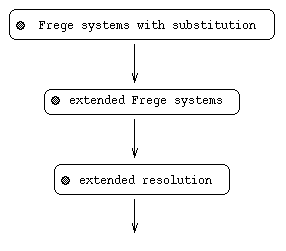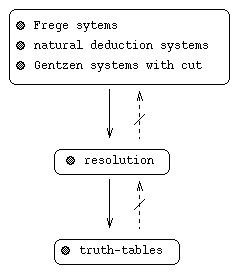Next: Equational term rewrite systems
Cook and Rechkow (1974/1979) looked at the question of whether or not
there exists a sound propositional calculus
![]() with an adequate set
of connectives such that tautologies have polynomial length derivations,
i.e., such that there is a polynomial p(x) with the property that every
tautology
with an adequate set
of connectives such that tautologies have polynomial length derivations,
i.e., such that there is a polynomial p(x) with the property that every
tautology
![]() has a derivation
has a derivation
![]() for which the total number of
occurrences of symbols in
for which the total number of
occurrences of symbols in
![]() is no more than
is no more than
![]() ,
,
![]() being the length of the string
being the length of the string
![]() .
Such a
.
Such a
![]() is said to be polynomially bounded. (If a polynomially
bounded propositional calculus exists then TAUT is in NP, and hence NP = co-NP.)
In an effort to study the above question they introduced the notion of
p-simulation (polynomial time simulation).
A propositional calculus
is said to be polynomially bounded. (If a polynomially
bounded propositional calculus exists then TAUT is in NP, and hence NP = co-NP.)
In an effort to study the above question they introduced the notion of
p-simulation (polynomial time simulation).
A propositional calculus
![]() p-simulates
another propositional calculus
p-simulates
another propositional calculus
![]() if there is a
polynomial time translation from formulas of
if there is a
polynomial time translation from formulas of
![]() to formulas of
to formulas of
![]() and a
polynomial time algorithm to convert derivations in
and a
polynomial time algorithm to convert derivations in
![]() into derivations of the translates in
into derivations of the translates in
![]() . If
. If
![]() and
and
![]() p-simulate each other then we say they are
p-equivalent.
Cook and Rechkow focused on variations of well-known propositional calculi
and arrived at the following relative strength diagram (where `arrow' as well as `is in the same box' in the
diagram means `p-simulates'):
p-simulate each other then we say they are
p-equivalent.
Cook and Rechkow focused on variations of well-known propositional calculi
and arrived at the following relative strength diagram (where `arrow' as well as `is in the same box' in the
diagram means `p-simulates'):


The main results are:
Next: Equational term rewrite systems
Fri Jan 31 11:29:59 EST 1997